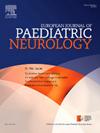Clinical presentation, MR imaging and outcome in children with myelin oligodendrocyte glycoprotein antibody-negative acute disseminated encephalomyelitis
IF 2.3
3区 医学
Q3 CLINICAL NEUROLOGY
引用次数: 0
Abstract
Background
Acute disseminated encephalomyelitis (ADEM) without myelin oligodendrocyte glycoprotein (MOG) antibodies (abs) presents a diagnostic challenge.
Objective
To investigate whether the diagnosis of MOG-negative (neg) ADEM was confirmed over time and to highlight the clinical and neuroradiological characteristics distinguishing monophasic MOG-neg ADEM from alternative diagnoses.
Material and methods
Children diagnosed with a first clinical episode of MOG-neg ADEM and a dataset including clinical presentation, MRI, CSF studies and at least 3-month follow-up were included.
Results
47 children with MOG-neg ADEM were identified (m:f = 27:20 , median age 8.0 years. 38 (79.2 %) children maintained the initial diagnosis after a median follow-up of 34.2 months. In 9 (19.1 %) children an alternative diagnosis was assigned after a median follow-up of 4.2 months including multiple sclerosis (MS) n = 2; glioblastoma (GBM) n = 2; hemophagocytic lymphohistiocytosis (HLH) n = 2; CNS vasculitis n = 1; ADEM followed by optic neuritis (ADEMON) n = 2. Cerebral white matter lesions were identified in 84.2 % of MOG-neg ADEM children. Gadolinium enhancement was noted in 11.4 % of MOG-neg ADEM children. Of 38 MOG-neg ADEM children, 9 (23.7 %) had only one atypical MRI finding, whereas 23 (60.5 %) showed multiple atypical MRI features. All children with alternative diagnoses exhibited more than one atypical MRI feature. The outcome was favorable (mRS </ = 2) in 36/38 (94.7 %) children with MOG-neg ADEM
Conclusion
A substantial number of children initially diagnosed with MOG-neg ADEM will have another diagnosis. Children with MOG-neg ADEM showed white matter lesions but also atypical MRI findings. Monophasic MOG-neg ADEM was associated with a favorable outcome.
髓鞘少突胶质细胞糖蛋白抗体阴性儿童急性播散性脑脊髓炎的临床表现、MR成像和预后
急性播散性脑脊髓炎(ADEM)没有髓鞘少突胶质细胞糖蛋白(MOG)抗体(abs)提出了诊断挑战。目的探讨mog阴性ADEM的诊断是否随着时间的推移而得到证实,并强调区分单相mog阴性ADEM与其他诊断的临床和神经影像学特征。材料和方法纳入了诊断为mog阴性ADEM首次临床发作的儿童,数据集包括临床表现、MRI、CSF研究和至少3个月的随访。结果共检出mog阴性ADEM患儿47例(m:f = 27:20),中位年龄8.0岁。38例(79.2%)患儿在中位随访34.2个月后仍维持初始诊断。在中位随访4.2个月后,9名(19.1%)儿童被指定为另一种诊断,包括多发性硬化症(MS) n = 2;胶质母细胞瘤(GBM) n = 2;噬血细胞淋巴组织细胞增多症(HLH) n = 2;中枢神经系统血管炎n = 1;ADEM合并视神经炎(addemon) n = 2。84.2%的mog阴性ADEM患儿出现脑白质病变。11.4%的mog阴性ADEM儿童出现钆增强。38例mog -阴性ADEM患儿中,9例(23.7%)仅表现出一种不典型MRI表现,23例(60.5%)表现出多种不典型MRI表现。所有有其他诊断的儿童都表现出不止一个不典型的MRI特征。在36/38例(94.7%)mog -阴性ADEM患儿中,预后良好(mRS </ = 2)。结论大量最初诊断为mog -阴性ADEM的患儿将出现其他诊断。mog阴性ADEM患儿表现为白质病变,但也有非典型MRI表现。单相mog -阴性ADEM与良好的预后相关。
本文章由计算机程序翻译,如有差异,请以英文原文为准。
求助全文
约1分钟内获得全文
求助全文
来源期刊
CiteScore
6.30
自引率
3.20%
发文量
115
审稿时长
81 days
期刊介绍:
The European Journal of Paediatric Neurology is the Official Journal of the European Paediatric Neurology Society, successor to the long-established European Federation of Child Neurology Societies.
Under the guidance of a prestigious International editorial board, this multi-disciplinary journal publishes exciting clinical and experimental research in this rapidly expanding field. High quality papers written by leading experts encompass all the major diseases including epilepsy, movement disorders, neuromuscular disorders, neurodegenerative disorders and intellectual disability.
Other exciting highlights include articles on brain imaging and neonatal neurology, and the publication of regularly updated tables relating to the main groups of disorders.

 求助内容:
求助内容: 应助结果提醒方式:
应助结果提醒方式:


